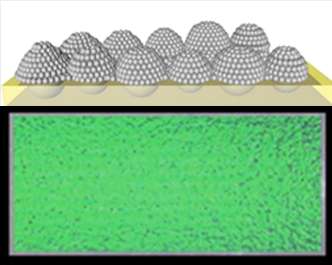Mimicking bug eyes could brighten reflective signs and clothes

That bright, reflective coating used on road signs, bicycles and clothing are important safety measures at night. They help drivers get to their destinations while avoiding bicyclists and pedestrians in low-light conditions. Now, inspired by the structure of insect eyes, scientists have developed new materials that could improve the color and effectiveness of these safeguards. Their report appears in the ACS journal Langmuir.
Retroreflective materials, including some tapes and road paints, work by bouncing light back toward the original source, such as a car's headlights, making them bright and easy to see. Existing retroreflectors are usually made with glass microbeads and microprisms. Dyes, pigments or plastic layers are often added for color; however, they tend to reduce the reflection of light, and the colors can fade over time. Hongta Yang and colleagues turned to the compound eyes of insects for a new way to address these limitations.
The researchers evenly coated an array of glass microspheres with smaller balls of silica. The result is a brilliantly colored, retroreflective material. The color can be adjusted by changing the size of the silica crystals, and brightness can be boosted by adding layers. At 250 nanometers and 40 layers deep, the crystals appeared bright green and reflected more light than commercial coatings with no color. In addition to boosting the brightness of objects for safety reasons, researchers say that by reflecting rather than absorbing light, the material could be applied to buildings to reduce the urban heat-island effect.
More information: Kuan-Yi Tsao et al. Self-Assembled Hierarchical Arrays for Colored Retroreflective Coatings, Langmuir (2016). DOI: 10.1021/acs.langmuir.6b03329
Abstract
This study reports a self-assembly technology for fabricating retroreflection coatings with hierarchical nano-/microstructures, which are inspired by the binary periodic structures found in the compound eyes of insects. Silica colloidal crystals of adjustable thicknesses are assembled on encountering glass microbeads using a Langmuir–Blodgett-like approach in a layer-by-layer manner. The as-assembled hierarchical structures exhibit a brilliant color caused by Bragg diffraction from the crystalline lattice of silica colloidal crystals on glass microbeads. The resultant coating is capable of reflecting light in the opposite direction of the incident light. Moreover, the dependence of the silica particle size, the colloidal crystal thickness, and the incident angle on the retroreflective properties are investigated in this study.
Journal information: Langmuir
Provided by American Chemical Society




















